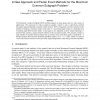Free Online Productivity Tools
i2Speak
i2Symbol
i2OCR
iTex2Img
iWeb2Print
iWeb2Shot
i2Type
iPdf2Split
iPdf2Merge
i2Bopomofo
i2Arabic
i2Style
i2Image
i2PDF
iLatex2Rtf
Sci2ools
COCOON
2005
Springer
2005
Springer
A New Approach and Faster Exact Methods for the Maximum Common Subgraph Problem
The Maximum Common Subgraph (MCS) problem appears in many guises and in a wide variety of applications. The usual goal is to take as inputs two graphs, of order m and n, respectively, and find the largest induced subgraph contained in both of them. MCS is frequently solved by reduction to the problem of finding a maximum clique in the order mn association graph, which is a particular form of product graph built from the inputs. In this paper a new algorithm, termed “clique branching,” is proposed that exploits a special structure inherent in the association graph. This structure contains a large number of naturally-ordered cliques that are present in the association graph’s complement. A detailed analysis shows that the proposed algorithm requires O((m + 1)n ) time, which is a superior worst-case bound to those known for previously-analyzed algorithms in the setting of the MCS problem.
Association Graph | COCOON 2005 | Combinatorics | Largest Induced Subgraph | Maximum Common Subgraph |
Related Content
| Added | 13 Oct 2010 |
| Updated | 13 Oct 2010 |
| Type | Conference |
| Year | 2005 |
| Where | COCOON |
| Authors | W. Henry Suters, Faisal N. Abu-Khzam, Yun Zhang, Christopher T. Symons, Nagiza F. Samatova, Michael A. Langston |
Comments (0)

